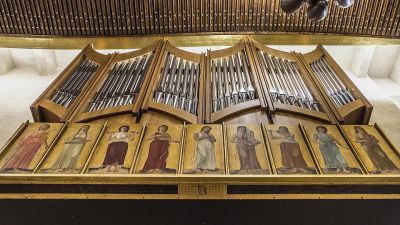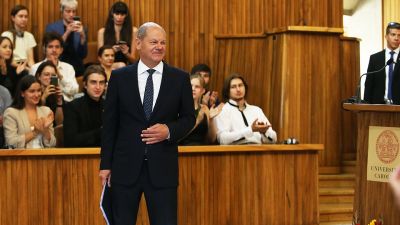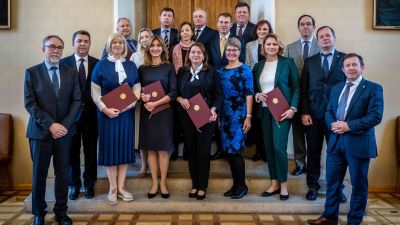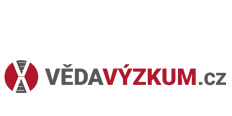It's one of the signature features of the Great Hall at the Carolinum: a 5 x 8 metre tapestry adoring the front wall of the aula. On it? An image of Holy Roman Emperor Charles IV with St. Wenceslas and symbols of the university’s faculties. The tapestry has graced the hall for 75 years. The Carolinum itself dates back to the 14th century.
The decorative tapestry was the brainchild of university officials already in 1934 and a commission to oversee the extensive renovation and restoration of the ancient building complex as well as plans to celebrate the 600th anniversary of the university’s founding (in 1948). The Commission for the Restoration of the Carolinum was established and in the first stage, mainly structural and historical research was carried out. The second phase was significantly delayed by the outbreak of the Second World War and construction work did not get underway in earnest until 1946.
The front wall was to be covered
On 22 February 1947, the commission decided at its meeting to order a tapestry with an image based on the ancient university seal. Why a tapestry? The reasons were twofold: both decorative as well as practical, as is evident from surviving correspondence from the Rector’s Office to the Ministry of Finance from the summer of 1947: “The choice of the tapestry is for the front wall of the aula … the tapestry is to cover the much-damaged front wall, where Gothic windows were newly uncovered, which have been much damaged… Their removal of which would be an irreparable offence. This old wall, with its valuable Gothic features, must be adapted in such a way that what is of historical value is preserved.”


The Great Hall before - and after - the tapestry went up in 1948. Photo: CU archive, archive of buidler Jan Lopata.
One of the options for covering the “defective” front wall was to create a mosaic, but this seemed uneconomical, as the material for the mosaic would have had to be imported from abroad. By contrast, a tapestry of such large dimensions would be a reminder to the world of the accomplishments of the Czechoslovak textile industry. The Rector’s Office also ventured at the time that the tapestry would not only be decorative, but also acoustic, of obvious importance in the hall.
A tapestry for one million
The Rector’s Office had to push hard for the tapestry, petitioning the Ministry of Education repeatedly after the Ministry of Finance rejected several requests for funds for the production of the item. The reason the Finance Ministry was not impressed? That the tapestry was a considerable luxury. For those days, the sums involved were large: 300,000 Czech crowns for the graphic design and the cost of the production of the tapestry itself was set at exactly 959,248 Czechoslovak crowns. For comparison: at the end of the 1950s, the monthly wage was 800 crowns. It was not a cheap solution, by any means.
It was not until October 1947 that the money was finally approved for the university and a few days later the university management was able to send a telegram to Marie Teinitzerová’s South Bohemian textile workshops in Jindřichův Hradec that they could begin work on the design by the painter Vladimír Sychra. The deadline for the completion of the tapestry was 1 April 1948, to allow time to hang it in the Great Hall before the celebration of the 600th anniversary of the university set for 10 April 1948.
The textile workshops in Jindřichův Hradec were not chosen by chance. Marie Teinitzerová, who also learned her craft in tapestry workshops in Paris, set up her own workshop as early as 1910 and was the founder of workshop-woven tapestry in Czechoslovakia. In 1925, she participated in the World Exhibition of Decorative Arts and gained an international reputation, winning commissions to produce tapestries based on designs by leading Czech artists. As in the case of Vladimír Sychra, who designed the university tapestry.
The structure of Vladimír Sychra's design stored in the Museum of Decorative Arts in Prague. PHOTO: Museum of Decorative Arts.
Sychra was inspired by the motif of the oldest university seal, where the kneeling Holy Roman Emperor and Czech King Charles IV hands the founding charter of Charles University to the Czech patron saint, St. Wenceslas. These figures, placed in the centre, are surrounded by heraldic figures of a lion and an eagle. At the top is the Gothic letter K – the initial from the university’s charter – which is flanked by the symbols of the four faculties: medical (a pelican feeding its young with its own blood) and philosophical (the earth and celestial bodies) on the left, law (scales) and divinity (an eagle pointing to the sun) on the right. In the lower strip of the painting there is a fragment of the Latin text of the university's founding charter. The original artwork is now preserved at the Museum of Decorative Arts in Prague.
The Teinitzerová workshops were used to producing large tapestries, but a commission for 5 x 8 metres was unusual, and so a new extension had to be built over the workshops in Jindřichův Hradec, as well as a new specially/built loom. In the autumn of the year the production of the university tapestry began, “in a density of four threads… the material being wool and natural silk, some gilded metal threads.”
Production of university tapestry in the workshops in Jindřichův Hradec. Marie Teinitzerová herself is present in the back on the left. PHOTO: State Regional Archive in Třeboň. Collection - Cultural and Historical Archive, inv. no. 747, carton no. 97, order no. 777.
The tapestry was woven in time and on 10 April 1948 it was one of the main decorations highlightened in the celebrations of the 600th anniversary of Charles University. In July 1948, the university management awarded Marie Teinitzer’s workshops with a commemorative bronze medal and a bronze jubilee badge for “the execution of a marvellous work that required exceptional effort and exertion.”
This certainly pleased Marie Teinitzerová, but the story of her company did not have a happy ending. Although in 1952 she was awarded the state prize of the second degree for her merits in the development of Czech textile art, her entire property was soon confiscated by Czechoslovakia’s new Communist regime. And the university tapestry, plus the two tapestry hangings for the balustrade of the Great Hall, was one of the last great works of her workshop before forced nationalisation transferred the successful company to state hands.
| You can see the beauty of the tapestry, the Great Hall and the entire Carolinum in detail in this unique virtual tour. |


























